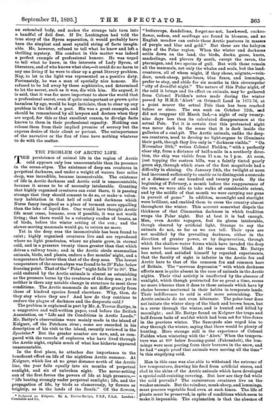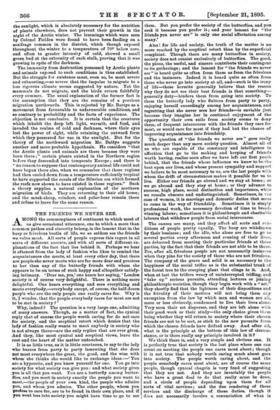THE PROBLEM OF ARCTIC LIFE.
Yet in the deep seas the inconceivable has been found to .exist; highly organised creatures live and are reproduced where no light penetrates, where no plants grow, in eternal cold, and in a pressure twenty times greater than that which drives a railway train; and in the Arctic circle mammalian animals, birds, and plants, endure a five months' night, and a temperature far lower than that of the deep seas. The lowest temperature of the ocean-abyss was found to be 29° Fahr. below freezing point. That of the " Polar "night falls 70° to 90°. The cold endured by the Arctic animals is almost as astonishing as the pressure borne by the creatures of the deep sea ; yet in neither is there any notable change in structure to meet these conditions. The Arctic mammals do not differ greatly from those of kindred species found elsewhere. Why, then, do they stay where they are ? And how do they continue to endure the plague of darkness and the desperate cold ?
The problem is explained in part by Mr. A. Trevor-Battye, in a suggestive and well-written paper, read before the British Association, on "Life and its Conditions in Arctic Lands." Mr. Battye's observations were mainly made in the island of Kolguev, off the Petchora river ; some are recorded in his description of his visit to the island, recently reviewed in the Spectator.* But the greater number are new, and, as com- pared with the records of explorers who have lived through the Arctic night, explain much of what has hitherto appeared unaccountable.
In the first place, he attaches due importance to the beneficent effect on life of the nightless Arctic summer. At Kolguev, which lies at no great distance north of the Arctic line, the year falls equally into six months of perpetual sunlight, and six of unbroken night. The never-setting sun of the first forces the powers of life at high pressure,— life beating strongly under perpetual sunlight ; life, and the propagation of life, by birds as clamorously, by flowers as brightly, as in the lands of the South." Of the flowers,
* Icaound on, Kolguero. By A. Trevor.Battye, P.Z.S P.L.S. London : Constable and Co. "buttercups, dandelions, forget-me-not, hawkweed, cuckoo. flower, sedum, and saxifrage are found in blossom, and no English meadow can outvie these Arctic pastures in masses of purple and blue and gold." But these are the halcyon days of the Polar region. When the winter and darkness settle down on the land, the birds, ducks, geese, knots, sanderlings, and plovers fly south, except the raven, the ptarmigan, and two species of gull. But with these remain all the mammals, not only the whales and seals, but the land- creatures, all of whom might, if they chose, migrate,—rein- deer, musk-sheep, polar-bears, blue foxes, and lemmings, prefer to stay, and abide for six months in this circumpolar "city of dreadful night." The nature of this Polar night, of the cold it brings and its effect on animals, may be gathered from Colonel Fielden's notes made during the winter passed by H.M.S. ' Alert ' on Grinnell Land in 1875.76, at a point nearer the actual Pole than has been reached before or since. The sun sank on October 12th, and did not reappear till March 2nd,—a night of only twenty. nine days less than its calculated disappearance at the actual Pole. Yet it is certain that this protracted night was never dark in the sense that it is dark inside the galleries of a coal-pit. The Arctic animals, unlike the deep- sea creatures, need to develop no light-organs to illuminate their path, tho-sgb they live only in "darkness visible." "On November 30th," writes Colonel Fielden, "with a perfectly clear sky, from a distance of half-a-mile in a southerly direc- tion, the ship was visible from 11 a.m. to 1 p.m. At noon, just topping the eastern hills, was a faintly tinted pearly green sky, through which stars of the first magnitude had a difficulty in shining. On January 24th, the twilight at noon had increased sufficiently to enable us to distinguish a comrade at a distance of one hundred and twenty yards. By the beginning of February, a month before the reappearance of the sun, we were able to take walks of considerable extent, and by the middle of that month we were carrying our guns in pursuit of game." In addition, moonlight and starlight were brilliant, and enabled them to cross the country almost throughout the winter. This account somewhat dispels the thickness of that Cimmerian darkness in which tradition wraps the Polar night. But at best it is bad enough. Men, even Arctic voyagers, feel its gloom intolerable, though cheered by artificial light. Strange to say the animals do not, so far as we can tell. Their eyes are not modified by the prevailing darkness, either in the direction of greater power, or by degeneration, through which the shallow-water forms which have invaded the deep seas have become blind. At the same time, Mr. Battye has noted, and satisfied himself by repeated experiments, that the faculty of sight is inferior in the Arctic fox and Arctic hare to that of the common fox and common hare of Britain. The "nervous depression" with which darkness affects men is quite absent in the case of animals in the Arctic nights. Their vital activity is unaffected by the absence of sunlight, which though protracted for so great a time, seems no more irksome than it does to those animals which have by choice become nocturnal in their habits in temperate lands. Their indifference to cold is still more astonishing. The Arctic animals do not even hibernate. The polar-bear does not imitate the winter sleep of the black and brown bears, but is a rover through the winter, and is bunted and killed by moonlight ; and Mr. Battye found on Kolguev the traps and half-frozen baits of seal-fat which had been set for blue-foxes in the previous winter. The Samoyeds also urged him to stay through the winter, saying that there would be plenty of hunting. More strange still is the experience of Colonel Fielden when wintering with the Alert.' When the tempera.- ture was at 80 below freezing-point (Fahrenheit), the lem- mings were seen peering from their burrows in the snow, and he had "ample proof that animals were moving all the time" in this stapifying cold.
Man in this case was also able to withstand the extreme of low temperature, drawing his food from artificial stores, and clad in the skins cf the Arctic animals which have developed a special cold-resisting covering. But how are they fed while the cold prevails? The carnivorous creatures live on the weaker animals. But the reindeer, musk-sheep, and lemmings, must procure vegetable food even at such times. The life of plants must be preserved, in spite of conditions which seem to make it impossible. The explanation is that the absence of the sunlight, which is absolutely necessary for the nutrition of plants elsewhere, does not prevent their growth in the night of the Arctic winter. The lemmings which were seen by Colonel Fielden were found to have been feeding on a saxifrage common in the district, which though exposed throughout the winter to a temperature of 74° below zero, and often to greater intensity of cold, showed a small green bud at the extremity of each stalk, proving that it was growing in spite of the darkness.
The immunity from destruction possessed by Arctic plants and animals exposed to such conditions is thus established. But the struggle for existence must, even so, be most severe and exhansting,—so severe that the impulse to migrate to a less rigorous climate seems suggested by nature. Yet the mammals do not migrate, and the birds return faithfully every summer. The usual explanation of the former fact is the assumption that they are the remains of a previous migration northwards. This is rejected by Mr. Bettye as a movement from favourable to unfavourable conditions, and so contrary to probability and the facts of experience. The objection is not conclusive. It is certain that the creatures which inhabit the deep left light, warmth, and food, and invaded the realms of cold and darkness, where their eyes lost the power of sight, while retaining the outward form which they possessed for use in the sunlight. But for the theory of the northward migration Mr. Battye suggests another and more probable hypothesis. He considers "that the Arctic plants and nnimals are there because they were born there ; " certain plants existed in the Northern region before they descended into temperate Europe ; and there is
no reason to suppose that contemporary animal life could not have begun there also, when we remember that these regions had then cooled down from a temperature sufficiently tropical to have supported the corals of the Silurian era which formed the reefs now shown to have existed in those regions." Such a theory supplies a natural explanation of the northern migration of birds. They are returning to their old home; and the musk-sheep, reindeer, and polar-bear remain there and refuse to leave for the same reason.



































 Previous page
Previous page